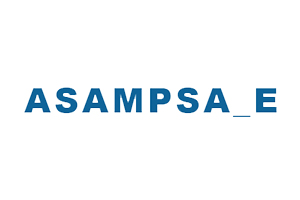
Since 2013, LEI participated in the Consortium, managed by the Institut de Radioprotection et de Sûreté Nucléaire (IRSN), by implementing EU Seventh Framework Programme project Advanced Safety Assessment Methodology: Extended PSA. The project activity began on July 1, 2013; the duration of the project was 36 months. 28 organizations from 18 European countries were partners of the project; several associate members from the USA and Japan also take part in the project: US-NRC, JANSI, and TEPCO.
The project particularly focused on probabilistic safety analysis of various extreme external hazards (meteorological, human induced and other events).
Project description in detail
LEI activities in the project
- WP10: Relationship with End-Users.
- WP21: Initiating events (internal and external hazards) modelling.
- WP22: How to introduce hazards in L1 PSA and all possibilities of events combination?
- WP30: General issues regarding extended PSA scope and applications.
- WP40: 2 Specific issues related to L2 PSA.
Laboratory researchers, by participating in the activities of all project work packages, in 2016 mostly focused on the activities related to identification and analysis of the initial events (internal and external hazards). Besides, a lot of attention was given to the needs of End-Users while conducting analyses of safety and with it related reports/methodologies. The largest contribution of LEI is to WP21/WP22 work packages. In them, LEI coordinated preparation of the report related to meteorological hazards and their impact (emphasizing extreme winds, including tornadoes, extreme temperatures and snow covering hazards).
Earlier in the corresponding work package the material for Link between external initiating events of PSA and NPP design basis conditions was presented.
Participation in such international projects as ASAMPSA_E allowed immediate access to the latest ideas on risk assessment and probabilistic analysis performance and application, also allowed contributing to new theoretical and applied research in the field of safety analysis. Future plans are to actively develop bilateral cooperation with ASAMPSA_E project participants.
Total cost: 4 043 346,65 EUR (LEI part: 75 150,00 EUR)
Coordinator: INSTITUT DE RADIOPROTECTION ET DE SURETE NUCLEAIRE, France
Participants:
- REGIA AUTONOMA PENTRU ACTIVITATI NUCLEARE DROBETA TR. SEVERIN RA SUCURSALA CERCETARI NUCLEARE PITESTI, Romania
- GESELLSCHAFT FUER ANLAGEN- UND REAKTORSICHERHEIT (GRS) MBH, Germany
- AMEC FOSTER WHEELER NUCLEAR UK LIMITED, United Kingdom
- RICERCA SUL SISTEMA ENERGETICO – RSE SPA, Italy
- LLOYD’S REGISTER CONSULTING – ENERGY AB, Sweden
- UJV REZ, A.S., Czech Republic
- UNIVERSITAT WIEN, Austria
- CAZZOLI ERRICO GIUSEPPECAZZOLI CONSULTING CC, Switzerland
- AGENZIA NAZIONALE PER LE NUOVE TECNOLOGIE,L’ENERGIA E LO SVILUPPO ECONOMICO SOSTENIBILE, Italy
- NUCLEAR RESEARCH AND CONSULTANCY GROUP, Netherlands
- IBERDROLA INGENIERIA Y CONSTRUCCION SA, Spain
- ELECTRICITE DE FRANCE S.A., France
- LIETUVOS ENERGETIKOS INSTITUTAS, Lithuania
- NUBIKI NUCLEAR SAFETY RESEARCH INSTITUTE LTD., Hungary
- FORSMARKS KRAFTGRUPP AB, Sweden
- AREVA NP SAS, France
- NARODOWE CENTRUM BADAN JADROWYCH, Poland
- STATE ENTERPRISE STATE SCIENTIFIC AND TECHNICAL CENTER FOR NUCLEAR AND RADIATION SAFETY, Ukraine
- VUJE AS, Slovakia
- NIER INGEGNERIA SPA, Italy
- VGB POWERTECH E.V., Germany
- TRACTEBEL ENGINEERING S.A., Belgium
- BEL V, Belgium
- INSTITUT JOZEF STEFAN, Slovenia
- INSTITUTE OF NUCLEAR RESEARCH AND NUCLEAR ENERGY – BULGARIAN ACADEMY OF SCIENCES, Bulgaria
- REGIA AUTONOMA TEHNOLOGII PENTRU ENERGIA NUCLEARA – RATEN, Romania
- TECHNICAL UNIVERSITY OF SOFIA, Bulgaria
- AREXIS SARL, France
Project Team
| Name, surname | Office | phone. | |
|---|---|---|---|
|
LEI Representative |
|||
| Robertas Alzbutas | 317-AK | +37037401945 | Robertas.Alzbutas@lei.lt |
|
Project Team |
|||
| Sigitas Rimkevičius | 204-AK | +37037401924 | Sigitas.Rimkevicius@lei.lt |
| Juozas Augutis | |||
| Algirdas Kaliatka | 223-AK | +37037401903 | Algirdas.Kaliatka@lei.lt |
| Eugenijus Ušpuras | |||
| Gintautas Dundulis | 434-AK | +37037401918 | Gintautas.Dundulis@lei.lt |
| Ričardas Krikštolaitis | |||
| Raimondas Pabarčius | 424-AK | +37037401919 | Raimondas.Pabarcius@lei.lt |
| Egidijus Urbonavičius | 105-AK | +37037401914 | Egidijus.Urbonavicius@lei.lt |
| Virginijus Vileiniškis | 251-AK | +37037401928 | Virginijus.Vileiniskis@lei.lt |
| Inga Šarūnienė | 314-AK | +37037401948 | Inga.Saruniene@lei.lt |
| Tomas Iešmantas | |||
| Benas Jokšas | |||
| Linas Martišauskas | 316-AK | +37037401938 | Linas.Martisauskas@lei.lt |
| Mantas Povilaitis | 254-AK | +37037401920 | Mantas.Povilaitis@lei.lt |
| Roman Voronov | 317-AK | +37037401945 | Roman.Voronov@lei.lt |





